Alienware M17x R4 Notebook Review: Ivy Bridge and the GeForce GTX 680M
by Dustin Sklavos on September 21, 2012 12:01 AM ESTGaming Performance
NVIDIA is quick to tout the performance jump from the GeForce GTX 580M/675M to the 680M in marketing materials, and it looks like they may be quite right to do so. On paper the GTX 680M's GK104 GPU has actually gone relatively unscathed in the transition from the desktop to the notebook, though the sacrifice in memory clocks is a painful one and enterprising users may even consider trying to trade off on core clocks for memory and see where that gets them.
That said, it stands to reason the M17x R4 is going to be the most powerful gaming notebook we've yet tested (at least until the M18x R2 review with two GTX 680Ms in SLI goes live). We'll start things off light with our Mainstream testing suite.
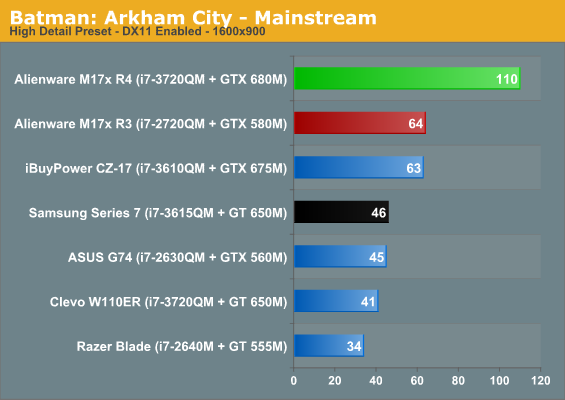

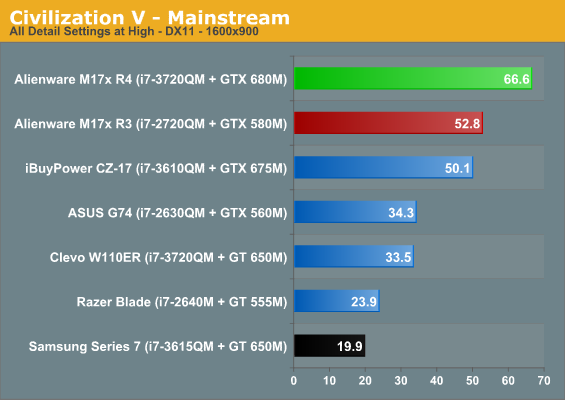
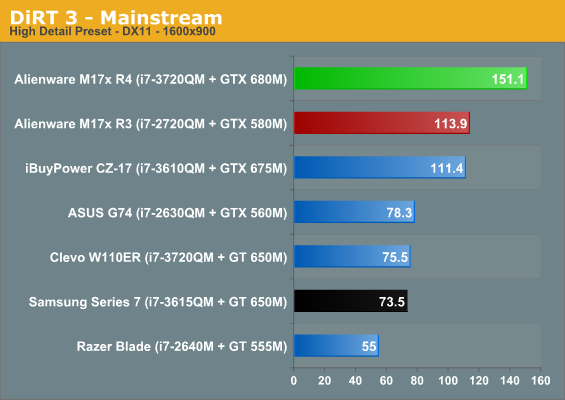

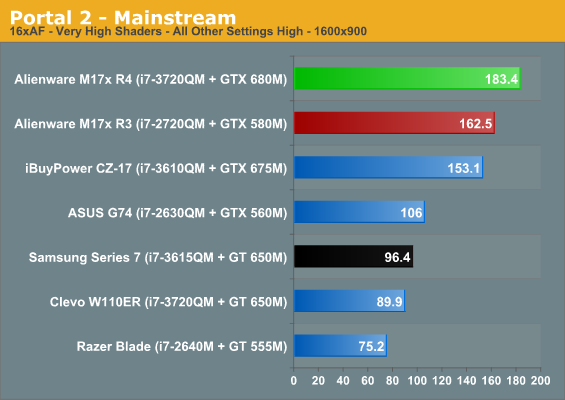
If you're not impressed and anxious to see how far the GTX 680M can go with higher settings, you should be. When the bottleneck is shifted to the GPU, performance over last generation's top end can be as much as 50% higher. That's a staggering leap. The 485M was a substantial leap over the horribly cut down and disappointing 480M, but this is an even larger one.
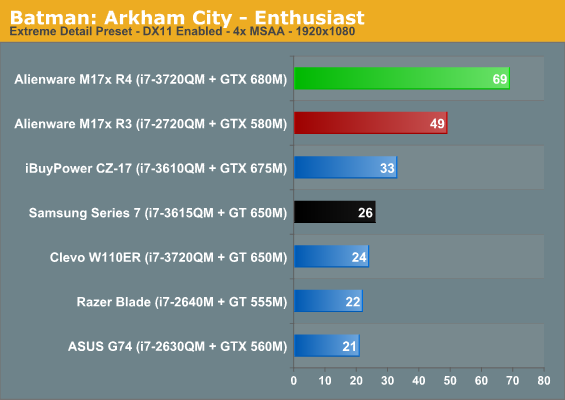
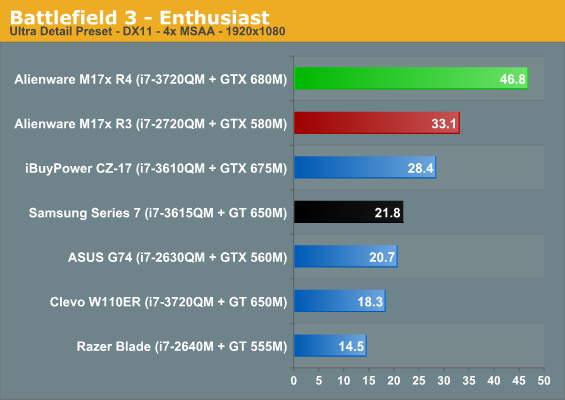
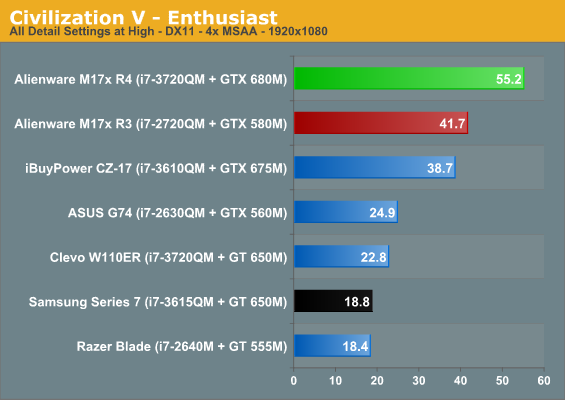

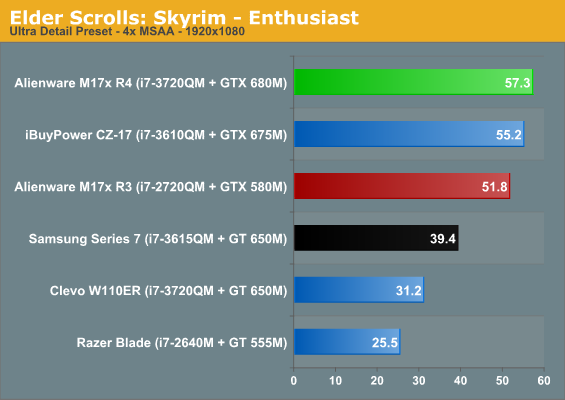

It continues. At any point where the GPU is the bottleneck, the GTX 680M runs screaming away from the 580M/675M. You'll pay handsomely for the jump in performance, but the 680M is capable of running nearly three times faster than the GT 650M (knowing that the M17x R4's entry level GPU is just a slightly faster version of that chip); die hard desktop enthusiasts are used to paying $550 for top end graphics hardware, and in that light the GTX 680M doesn't look like such a raw deal. We'll have to wait and see how it compares to the HD 7970M before we can determine whether or not it's worth the extra $300 over that chip, though there's also the Optimus vs. Enduro debate along with driver considerations (which will hopefully all be ironed out in the next month or two).










61 Comments
View All Comments
shadowyani - Friday, September 21, 2012 - link
At least the keyboard no longer ghosts.knekker - Friday, September 21, 2012 - link
I don't understand why Anandtech are wasting their time reviewing this laptop, when (appart from the CPU) MSI for quite some time has a significant better offer, compared to this overpriced brick.http://www.laptopmag.com/review/laptop/msi_gt70_on...
DanNeely - Friday, September 21, 2012 - link
I think that's the same laptop platform that they reviewed in iBuy Power branding a month ago. Specs aren't identical with laptopmag's test model; but reviewing two models of the same platform offers little value compared to looking at a second vendors design.http://www.anandtech.com/show/6173/ibuypower-valky...
nerd1 - Friday, September 21, 2012 - link
M17XR4 with 7970M can be found around $1800 from various vendors - and 7970M is not too shabby against 680M and totally smokes 675M / 6990M GPU.I'd rather get m17xr4 w/7970M than spending almost the same money to cz17 with 680M. If I'm paying almost $2000 for a gaming laptop, I won't get fugly laptops.
tviceman - Friday, September 21, 2012 - link
Why does Nvidia hate memory bandwidth so much?DanNeely - Friday, September 21, 2012 - link
high clock rates suck power; in mobile platforms they want to minimize that as much as possible. They're also not stupid and I see no reason not to assume their default GPU/memory clocks were picked to give the maximum average fps scores within their target TDP.Harmattan - Friday, September 21, 2012 - link
I've owned and spent hours and hours with both single and dual configurations of the 7970m and 680m (have an m18x with dual 680ms right now). In single configuration, on an Alienware, 7970m is the way to go: drivers are nearly as good as nVidia's and performance with the 680m is neck-and-neck (which 680m being about 7% faster on avg.). The $250 lower price of the 7970m vs. the 680m wins.That said, a single 7970m has problems on Clevo laptops in the form of AMD's god-awful power management system, Enduro. You see around 10% reduced performance on Clevos/Sagers when compared to Alienware's which do not have the Enduro issue. If you're going Clevo/Sager, go 680m.
Finally, 7970m Crossfire drivers are a bit of a mess: lower gains than nV and, in some games, no gain at all over a single GPU. If you're going dual GPU in a laptop, go 680m SLI.
JarredWalton - Friday, September 21, 2012 - link
Enduro can be even more than a 10% loss of performance -- try more like 30-50% in some games (depending on settings). However, AMD is aware of the problem and tells me they're working on a fix that should hit in the next month. We'll see... 7970M Clevo review coming soon from me, though!prophet001 - Friday, September 21, 2012 - link
That GPU is impressive. Even on Civ 5 it holds its own.Nice review, nice laptop.
Thank you
Death666Angel - Friday, September 21, 2012 - link
Really a pity they didn't do any updates except replace the innards. If there every was a time to buy a gaming laptop, it would be today, 60 fps @1080p with their hardware being up to date until late 2013 when the new console generation hits. Not bad.I like the HDMI in btw. Don't see that very often. :-)